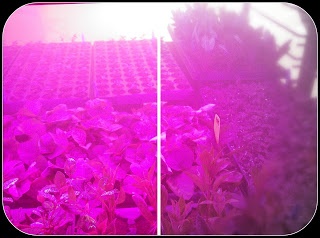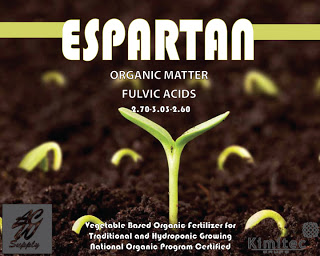David Kuack and Vijay Rapaka
growing substrate materials that have been used for hydroponic crop production
include rockwool, perlite, vermiculite, expanded clay and pea gravel. Phenolic
foam is a relatively new inorganic substrate that offers many desirable
production properties.
cubes
Oasis Horticube Growing Medium is a sterile phenolic foam. Like rockwool,
Horticubes have no cation exchange capacity, no
buffering capacity and no initial fertilizer charge.
(276 cubes/sheet), 1-inch (162 cubes/sheet), 1¼-inch (104 cubes/sheet) and 1½-inch
(50 cubes/sheet). All of the sheets measure 10- by 20-inches and fit into
standard 1020 trays. Each sheet is pre-scored on the bottom and top to allow
for easy separation of the cubes at transplant.
hydroponic lettuce production. This high density configuration accommodates 276
seeds in a standard 1020 tray. Each cube is pre-punched with a dibble hole that
is uniform in depth and has center to center spacing. This allows for the use
of automated seed sowing equipment. Horticubes work equally well with both nutrient
film technique (NFT) and a raft (float) growing system.
Thin-Cut Horticube has a water-holding capacity of 80 percent and air porosity
of 20 percent. A comparable rockwool product, which has grooves at the bottom
of the sheet, has a water-holding capacity of 60 percent and air porosity of 40
percent.
to sowing the seed. Seed can be sown using a vacuum seeder or manually by
placing the seed in the dibble holes. The specially designed hole is tapered to
ensure the seed sets properly in each cube.
and water breaker (i.e., wide fan nozzle) or automatically by passing the
Horticube sheets through a watering tunnel. The sheets should be thoroughly
saturated.
capacity
However, it takes more than 4 liters of water to ensure total saturation of the
foam because of water channeling through the dibble holes and grooves on the Horticube
sheet. To ensure thorough saturation about 10 liters (2.6 gallons) should be
applied so that the water pours through the bottom of the sheet. As rule of
thumb, water each sheet for 2 minutes at regular tap water pressure.
irrigation, place the Horticube sheets in solid bottom trays with drain holes. Never
use a solid bottom tray without drain holes. If sub-irrigation is going to be
used, place the Horticube sheets in trays that have solid sides and web bottoms.
media should not be allowed to go completely dry between waterings.
stay moist during the course of germination.
with vermiculite. The seed also does not require a dark treatment for germination.
The best germination usually occurs when the Horticube temperature is below
70°F. The seed usually germinates in two to three days.
and fertilizing seedlings
or watering during germination. However, on bright hot summer days consider a
brief misting (5 seconds once a day) on Day 2 and Day 3. Apply clear tap water
with no fertilizer.
be adjusted. A typical misting program consists of starting from Day 4 to Day
7, three times a day for 10 seconds. From Day 7 to finish, mist four times a
day for 10 seconds. If the seedlings are going to be either hand-watered or on
a sub-irrigation system, irrigate only once a day.
nutrient formulations developed for lettuce production will work with
Horticubes. Growers should customize their specific formulations depending on
water supply, lettuce cultivars, production system, climate and season. The
nutrient solution pH should range from 5.5 to 6. The recommended electrical
conductivity during propagation is 1.0 mS/cm. The recommended electrical
conductivity during production is 1.2 to 2.2 mS/cm.
seedlings
after sowing depending on seasonal climate conditions. During summer months it
takes about 10 days from sowing to transplant and during winter months it takes
about14 days. The criteria for transplant are development of two true leaves
and root penetration through the bottom of the Horticubes.
individual cubes. The easiest way is to break the individual cubes from the top
down along the scoring.
and harvest
system perform equally well. During production the recommended electrical
conductivity of the nutrient solution should be 1.2 to 2.2 mS/cm. With a NFT
system the water flow rate should be 1 to 1.2 liters per minute. Analysis of
the nutrient solution should be done on a regular basis in order to make
formulation adjustments.
with the root system intact. Leaving the root system intact can help to extend
the shelf life of the lettuce.
North America; (800) 321-8286; www.oasisgrower.com or Hort Americas, LLC at +1 469 532 2383.
Kuack is a freelance technical writer in Fort Worth, Texas, dkuack@gmail.com.
Dr. Vijay Rapaka is Manager—Grower Research, Smithers-Oasis Co., Kent, Ohio, vrapaka@smithersoasis.com.
Visit our corporate website at https://hortamericas.com














